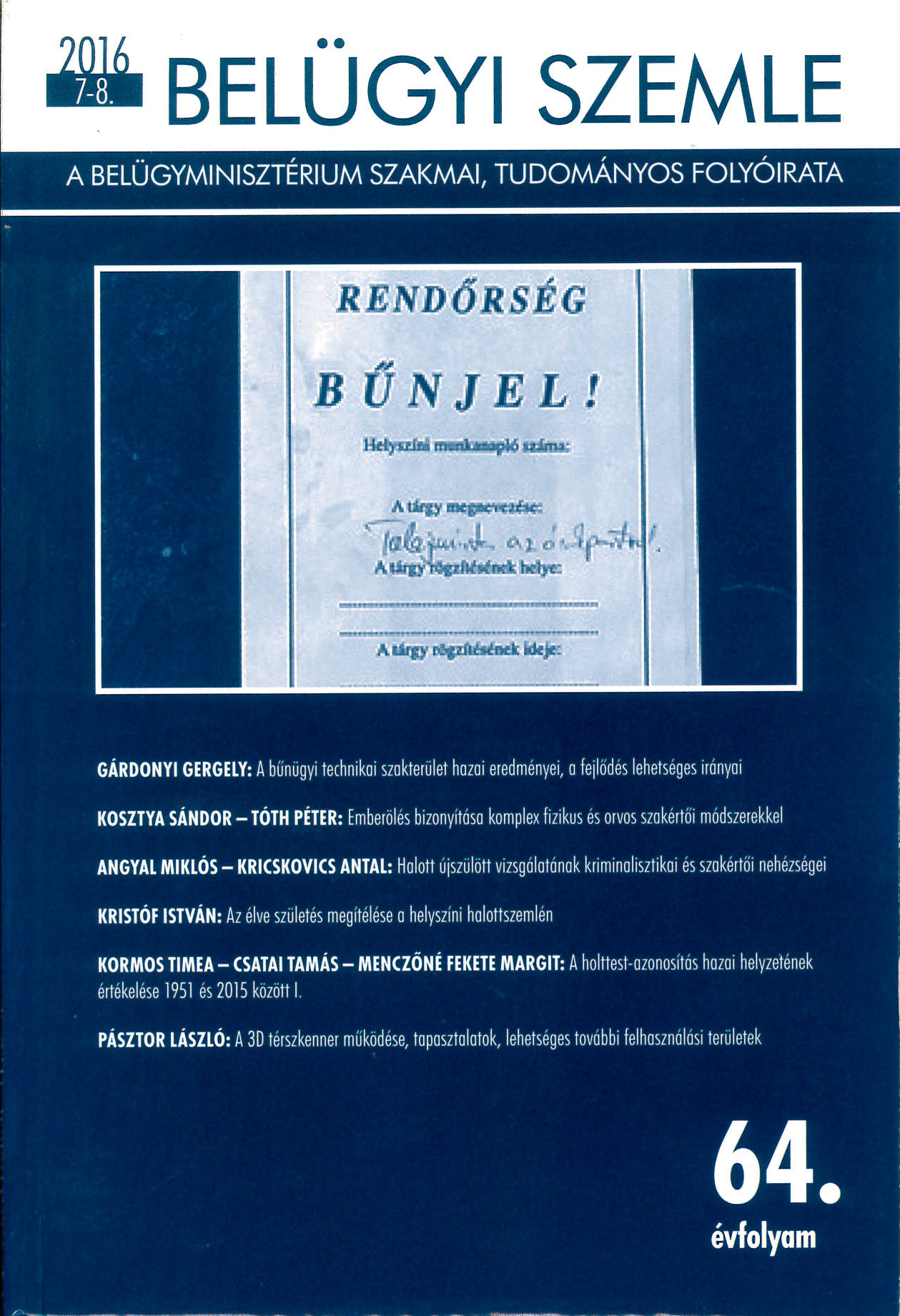Keywords
3D imaging
forensic sciences
using in practice
forensic sciences
using in practice
How to Cite
Three-dimensional imaging in forensic sciences. (2016). Academic Journal of Internal Affairs, 64(7-8), 77-86. https://doi.org/10.38146/BSZ.2016.7-8.8
Abstract
The author provides an overview of three-dimensional forensic imaging. 3D laser scanning, handheld portable 3D scanners and 3D microscopy are used in practice.
Downloads
Download data is not yet available.
Similar Articles
- Lajos Hertelendi, Integrity with the “EYE” (SZEM) of law enforcement - or the law enforcement-specific features of solid morality in the service of corruption prevention , Academic Journal of Internal Affairs: Vol. 69 No. 11 (2021)
- József Haller, Attila Petőfi, Kristóf Mészáros, The ease and difficulty of profiling – a perspective approach , Academic Journal of Internal Affairs: Vol. 69 No. 12 (2021)
- Ágnes Lehoczki, Csaba Ronyecz, Homicide through the perspective of investigation and psychological profiling – a case study , Academic Journal of Internal Affairs: Vol. 69 No. 12 (2021)
- Gyöngyike Juhász, The forensic data collection, the future and the research opportunities of the electronic Modus Operandi Registration , Academic Journal of Internal Affairs: Vol. 70 No. 1 (2022)
- Noémi Emőke Baráth, Motivation and Attitudes Behind the Career Choices of Hungarian Student Police Officers in Light of Policing Models , Academic Journal of Internal Affairs: Vol. 71 No. 2.ksz. (2023): Special Issue
- Bálint Kolozsi, International cooperation in criminal matters, Joint Investigation Team involving Hungary, Germany, Romania , Academic Journal of Internal Affairs: Vol. 70 No. 2 (2022)
- Julianna Huszár, Rethinking trafficking in human beings - the effectiveness of the provisions that entered into force on 1 July 2020 from a prosecutorial perspective , Academic Journal of Internal Affairs: Vol. 70 No. 2 (2022)
- Péter Antalóczy, István Sándor Nagy, On the introduction of a university course titled „Combating Trafficking in Human Beings in Europe” and its practical benefits , Academic Journal of Internal Affairs: Vol. 70 No. 2 (2022)
- Zsolt Lippai, Past and present of police non-comissioned officer training , Academic Journal of Internal Affairs: Vol. 70 No. 4 (2022)
- László Fázsi, Magdolna Fekete, Reverence issues in criminal law , Academic Journal of Internal Affairs: Vol. 70 No. 5 (2022)
You may also start an advanced similarity search for this article.
Most read articles by the same author(s)
- Márton Lontai, Horolma Pamzsav, Dávid Petrétei, Artificial Intelligence in Forensic Sciences Revolution or Invasion? , Academic Journal of Internal Affairs: Vol. 72 No. 4 (2024)
- Dávid Petrétei, Criminalistics, police science, forensic sciences – reflections on the anniversary of the Hungarian Association of Police Science , Academic Journal of Internal Affairs: Vol. 72 No. 5 (2024)
- Márton Lontai, Horolma Pamzsav, Dávid Petrétei, Artificial Intelligence in Forensic Sciences Revolution or Invasion? Part II , Academic Journal of Internal Affairs: Vol. 72 No. 8 (2024)
- Márton Lontai, Horolma Pamjav, Dávid Petrétei, Artificial Intelligence in Forensic Sciences Revolution or Invasion? Part II , Academic Journal of Internal Affairs: Vol. 72 No. 8 (2024)
- Dávid Petrétei, Criminalistics, police science, forensic sciences – reflections on the anniversary of the Hungarian Association of Police Science , Academic Journal of Internal Affairs: Vol. 72 No. 5 (2024)
- Dávid Petrétei, The Future of the Criminalistics, the Criminalistics of the Future , Academic Journal of Internal Affairs: Vol. 62 No. 10 (2014)
- Dávid Petrétei, Theoretical Issues of Forensic Identification , Academic Journal of Internal Affairs: Vol. 68 No. 2 (2020)
- Dávid Petrétei, Print development from human skin , Academic Journal of Internal Affairs: Vol. 63 No. 11 (2015)
- Dávid Petrétei, Theoretical Issues of the Trace and Pattern Evidences in the 21th Century , Academic Journal of Internal Affairs: Vol. 70 No. 5 (2022)
- Dávid Petrétei , Modern Methods of Latent Print Development I - Physical Methods , Academic Journal of Internal Affairs: Vol. 71 No. 4 (2023)

